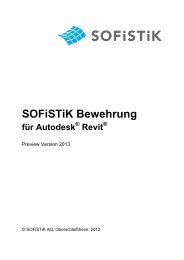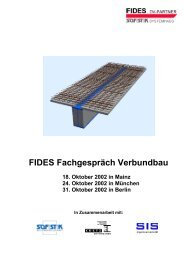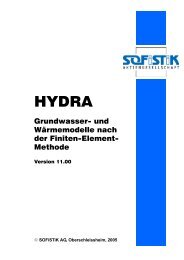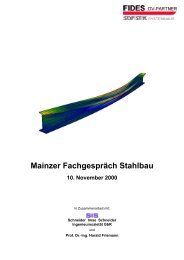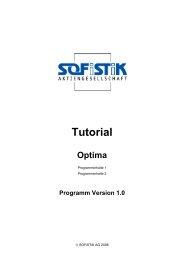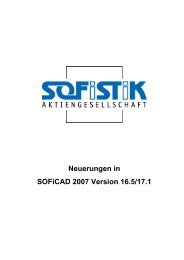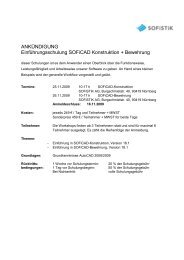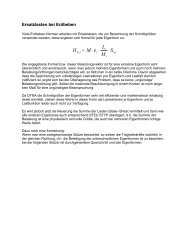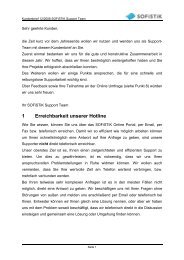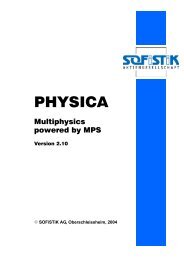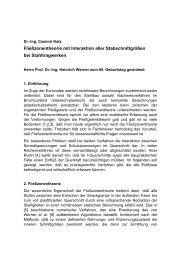Use of CFD in Civil Engineering (PDF) - SOFiSTiK AG
Use of CFD in Civil Engineering (PDF) - SOFiSTiK AG
Use of CFD in Civil Engineering (PDF) - SOFiSTiK AG
You also want an ePaper? Increase the reach of your titles
YUMPU automatically turns print PDFs into web optimized ePapers that Google loves.
<strong>Use</strong> <strong>of</strong> Computational Fluid Dynamics <strong>in</strong> <strong>Civil</strong> Eng<strong>in</strong>eer<strong>in</strong>g<br />
Pr<strong>of</strong>. Dr.-Ing. Casimir Katz, <strong>SOFiSTiK</strong> <strong>AG</strong>, Oberschleißheim<br />
ir. Henk Krüs, Cyclone Fluid Dynamics BV, Waalre<br />
Zusammenfassung:<br />
Der E<strong>in</strong>satz von <strong>CFD</strong> im Bauwesen stellt nach wie vor e<strong>in</strong>e Nischenanwendung dar. Die Gründe<br />
dafür werden beleuchtet und aufgezeigt, warum sich das jetzt ändern wird.<br />
Summary:<br />
The use <strong>of</strong> <strong>CFD</strong> <strong>in</strong> the civil eng<strong>in</strong>eer<strong>in</strong>g community is still a rare event. The reasons for that will be<br />
discussed and it will be po<strong>in</strong>ted out why that will change now.<br />
1 INTRODUCTION<br />
1.1 Fluid dynamics and their applications<br />
<strong>CFD</strong> is the acronym for „Computational Fluid Dynamics“. Fluids <strong>in</strong> civil eng<strong>in</strong>eer<strong>in</strong>g are mostly<br />
air and water and the questions to be answered are the forces <strong>in</strong>duced by fluid motion and the<br />
transport <strong>of</strong> heat or particles with<strong>in</strong> the fluid. Typical questions are<br />
W<strong>in</strong>d load<strong>in</strong>g on bluff bodies<br />
W<strong>in</strong>d load<strong>in</strong>g on mov<strong>in</strong>g bodies, especially bridges<br />
W<strong>in</strong>d comfort and nuisance to cyclists and pedestrians<br />
W<strong>in</strong>d energy<br />
Heat<strong>in</strong>g and Ventilation (HVAC)<br />
Fire safety eng<strong>in</strong>eer<strong>in</strong>g<br />
Wave load<strong>in</strong>gs<br />
The difference to classical static or dynamic analysis is given by a different mathematical treatment<br />
and thus different mathematical tools [1]. While structural mechanics use the Lagrangian approach<br />
based on displacements, fluid mechanics prefer the Eulerian approach based on the velocity <strong>of</strong> the<br />
fluid. Structural mechanics use the F<strong>in</strong>ite Element Method, most fluid mechanics use the F<strong>in</strong>ite<br />
Volume Method. The basic pr<strong>in</strong>ciples <strong>of</strong> equilibrium and conservation <strong>of</strong> mass, energy and<br />
momentum are common to both methods.<br />
V13 - 1
1.2 S<strong>of</strong>tware for <strong>CFD</strong><br />
S<strong>of</strong>tware for <strong>CFD</strong> has been developed for a long time now, the most well known products today are<br />
the big three FLUENT (now Ansys), STAR-CD/STAR-CCM (CD-Adapco) and CFX (now Ansys),<br />
but there are many more like the <strong>CFD</strong>DRC (now ESI-Group), <strong>CFD</strong>esign (FEM by Blue Ridge<br />
Numerics, now Autodesk) and FDS (by NIST). There are also different techniques available like<br />
vortex particle and Lattice-Boltzmann methods.<br />
The first impression for a structural eng<strong>in</strong>eer is, that everyth<strong>in</strong>g is very complex, that there are<br />
hundreds <strong>of</strong> features and parameters and that it will cost a fortune to start <strong>in</strong>to this field. Over the<br />
years the mantra <strong>of</strong> a technique much too complex for the common eng<strong>in</strong>eer and high licence costs<br />
has established significant barriers. The same happened to structural FE-S<strong>of</strong>tware <strong>in</strong> the late<br />
seventies. <strong>SOFiSTiK</strong> had success because we anticipated the wide spread <strong>of</strong> that technique on<br />
personal computers <strong>in</strong> 1980.<br />
But the <strong>CFD</strong>-market is chang<strong>in</strong>g now, cheaper versions <strong>of</strong> <strong>CFD</strong>-s<strong>of</strong>tware enter the market, and the<br />
open source s<strong>of</strong>tware OpenFOAM has ga<strong>in</strong>ed wide acceptance especially <strong>in</strong> the academic world.<br />
However the structural beg<strong>in</strong>ner is still overwhelmed by a wide range <strong>of</strong> features. What is needed is<br />
a robust, easy to use entry po<strong>in</strong>t for this journey.<br />
<strong>SOFiSTiK</strong> has ga<strong>in</strong>ed some experience with an academic multiphysics s<strong>of</strong>tware PHYSICA and is<br />
now support<strong>in</strong>g DOLFYN, an open source <strong>CFD</strong>-Solver used <strong>in</strong> practice <strong>in</strong> many eng<strong>in</strong>eer<strong>in</strong>g fields,<br />
which has been fully <strong>in</strong>tegrated <strong>in</strong> the <strong>SOFiSTiK</strong> environment.<br />
2 BASICS<br />
2.1 Fluid dynamics and their solvers<br />
Two important metrics are the Mach number (v/c) def<strong>in</strong><strong>in</strong>g the ratio <strong>of</strong> the fluid velocity v to the<br />
speed <strong>of</strong> the sound c and the Reynolds number derived from the fluid velocity u, the k<strong>in</strong>ematic<br />
viscosity n, and a characteristic dimension <strong>of</strong> the structure (like the diameter <strong>of</strong> a cyl<strong>in</strong>der or the<br />
height <strong>of</strong> a bridge deck):<br />
d u<br />
Re <br />
<br />
k<strong>in</strong>ematic viscosity<br />
d characteristicdimension<br />
Air<br />
2<br />
6 m<br />
1510 sec<br />
; Water<br />
2<br />
6<br />
m<br />
1. 3110 sec<br />
V13 - 2
Fluid dynamics cover a broad range <strong>of</strong> fields, some <strong>of</strong> them are:<br />
Potential Flow (Re = ∞ )<br />
Creep<strong>in</strong>g Flow (hardly any flow)<br />
Lam<strong>in</strong>ar <strong>in</strong>compressible viscous flow<br />
(Navier Stokes)<br />
Turbulent Flow (Re large)<br />
Compressible Flow (Ma > 0.3)<br />
Supersonic Flow (Ma > 1.0)<br />
Thermal Effects<br />
Combustion & chemical reaction<br />
Free Surfaces<br />
Non-Newtonian fluids<br />
Radiation<br />
In civil eng<strong>in</strong>eer<strong>in</strong>g applications the subsonic <strong>in</strong>compressible turbulent flow is the most common<br />
phenomenon. Compressible flow is needed for shocks and high temperature effects. The major<br />
rema<strong>in</strong><strong>in</strong>g problem is that a direct solution <strong>of</strong> the Navier-Stokes-equations is only possible for<br />
Reynolds-numbers up to approximately 20 000, while practical examples are <strong>in</strong> the range <strong>of</strong> several<br />
millions. Thus turbulence has to be modelled by RANS (Reynolds-Average-Navier-Stokes) models<br />
allow<strong>in</strong>g for very large Reynolds numbers but do not model all effects, that’s why LES (Large Eddy<br />
Simulation) has ga<strong>in</strong>ed some popularity, but requires still high computational effort.<br />
2.2 Materialparameters<br />
The selection <strong>of</strong> fluid material parameters is straight forward: There is a density [kg/m³], a dynamic<br />
viscosity [Pa sec], a compressibility [Pa/m²] and some thermal properties.<br />
2.3 Boundary Conditions<br />
Inflow and outflow boundary conditions are <strong>in</strong> general not complex, but there is a major problem<br />
with two aspects. There exists a boundary layer at every wall. At the wall itself there is no flow,<br />
then we have a t<strong>in</strong>y lam<strong>in</strong>ar viscous sublayer, followed by the turbulent boundary layer. The<br />
treatment <strong>of</strong> the wall boundary condition is quite difficult. Though there are possibilities for near<br />
wall models, the common model is a logarithmic wall law describ<strong>in</strong>g the complete wall boundary<br />
behaviour for a cell sufficiently far away from the boundary:<br />
V13 - 3
However the atmospheric boundary layer has a height larger than one kilometre, thus all civil<br />
eng<strong>in</strong>eer<strong>in</strong>g structures are completely encompassed by it. The design codes for w<strong>in</strong>d load<strong>in</strong>gs<br />
describe the layer with a logarithmic or an exponential law.<br />
It is not only the velocity but also the turbulence characteristics like the k<strong>in</strong>etic energy (turbulence<br />
<strong>in</strong>tensity) and the dissipation rate (Integral length scale) which need to be described. The correct<br />
formulation requires not only to model the roughness <strong>of</strong> the ground with the correct value <strong>of</strong> z0, the<br />
driv<strong>in</strong>g force at the top <strong>of</strong> the fluid doma<strong>in</strong>, but also the treatment <strong>of</strong> the analytic solution <strong>of</strong> the<br />
turbulence equations as <strong>in</strong>itial conditions, which are fully implemented <strong>in</strong> DOLFYN:<br />
*<br />
u ABL zz 0<br />
uz ( ) ln<br />
<br />
z0<br />
<br />
* 2<br />
uABL<br />
kz ( ) <br />
C<br />
<br />
u<br />
( z)<br />
<br />
<br />
V13 - 4<br />
* 3<br />
ABL<br />
zz <br />
0
3 MODELLING<br />
3.1 W<strong>in</strong>dtunnel or <strong>CFD</strong> ?<br />
A w<strong>in</strong>d tunnel is just a model <strong>of</strong> the reality, so is any <strong>CFD</strong> model. The w<strong>in</strong>d tunnel needs scal<strong>in</strong>g,<br />
Reynolds number is not the same and there are cases where this does matter. There is a guidel<strong>in</strong>e<br />
from the WTG (W<strong>in</strong>dtechnologische Gesellschaft) describ<strong>in</strong>g <strong>in</strong> detail how to perform reliable<br />
tests.<br />
But for flexible structures, the measurement equipment may change the effects considerably. On the<br />
other side there are known deficiencies <strong>of</strong> numerical analysis, which do not allow tak<strong>in</strong>g all results<br />
for granted. “The purpose <strong>of</strong> comput<strong>in</strong>g is <strong>in</strong>sight, not numbers.” said R. Hamm<strong>in</strong>g <strong>in</strong> 1962. So the<br />
question is not which technique to be used but how to comb<strong>in</strong>e both methods to their best use.<br />
3.2 Reality or design case ?<br />
Is the requested result the mean values <strong>of</strong> the w<strong>in</strong>d load<strong>in</strong>g for a static analysis or the variation <strong>of</strong><br />
forces <strong>in</strong> time either to account for dynamic effects or to get reasonable loads at all. For example a<br />
flat horizontal ro<strong>of</strong> on columns will have a zero pressure as mean value, but the w<strong>in</strong>d load is <strong>of</strong><br />
course not zero!<br />
What is appropriate for the design <strong>of</strong> a build<strong>in</strong>g for w<strong>in</strong>d load<strong>in</strong>g, a solitaire <strong>in</strong> an empty<br />
environment:<br />
V13 - 5
Or the with<strong>in</strong> the true environment:<br />
Most design codes describe w<strong>in</strong>d pr<strong>of</strong>iles based on the roughness <strong>of</strong> the terra<strong>in</strong>, for urban<br />
environment the value <strong>of</strong> z0 may be over 2.0 m, which is not suitable as roughness for a <strong>CFD</strong> wall<br />
boundary condition <strong>in</strong> general, although it is possible for an <strong>in</strong>let w<strong>in</strong>d pr<strong>of</strong>ile. The ma<strong>in</strong> purpose is<br />
to def<strong>in</strong>e loads just based on the velocity distribution, not to perform a fluid analysis. This can be<br />
clearly seen by the fact that the velocity does not vanish at the ground.<br />
For a w<strong>in</strong>d tunnel test normally the whole environment is modelled. So to compare <strong>CFD</strong> and w<strong>in</strong>d<br />
tunnel, the model size <strong>of</strong> the w<strong>in</strong>d tunnel (<strong>in</strong>clud<strong>in</strong>g the true geometry <strong>of</strong> the equipment) may be<br />
analyzed but the analysis <strong>of</strong> the true scale <strong>of</strong> the natural model <strong>in</strong>clud<strong>in</strong>g the environment should be<br />
more adequate.<br />
And is our <strong>in</strong>terest <strong>in</strong> a model match<strong>in</strong>g reality as close as possible or can we agree on a model on<br />
the safe side?<br />
V13 - 6
4 EXAMPLE BUILDING<br />
Gerhardt [3] has reported considerable deviations between a <strong>CFD</strong>-Analysis and measurements for a<br />
hull <strong>of</strong> a build<strong>in</strong>g (Re = 4·10 7 ), given with a picture as follows:<br />
As all other data was miss<strong>in</strong>g, personal enquiries yielded a pr<strong>of</strong>ile exponent <strong>of</strong> 0.25 (w<strong>in</strong>d tunnel)<br />
and 0.27 (analysis), a rather sufficiently large air volume <strong>of</strong> 2000 x 2000 x 500 m and some<br />
<strong>in</strong>homogenities along the build<strong>in</strong>g and other neighboured build<strong>in</strong>gs <strong>in</strong> the w<strong>in</strong>d tunnel test. Some<br />
tests showed however that the effect <strong>of</strong> those build<strong>in</strong>gs should be neglectable allow<strong>in</strong>g to<br />
concentrate on a 2D section.<br />
Thus the section was digitized from the picture, scaled to the real dimensions <strong>of</strong> 55 m width and 25<br />
m height and an air volume with 500 m distance to the boundaries was used. The mesh density on<br />
the hull was selected with 0.25 cm (approx. 30 y+) yield<strong>in</strong>g a total <strong>of</strong> 12500 cells.<br />
V13 - 7
The first outcome <strong>of</strong> the analysis showed, that the selection <strong>of</strong> the turbulence model had a<br />
significant effect on the pressure distribution, the standard k- model created the distribution with<br />
the large peaks (left picture) while the RNG-model showed better results (right picture):<br />
A deeper look at the <strong>in</strong>flow parameters however showed some deficiencies. Input velocity and<br />
turbulence <strong>in</strong>tensities are well known, but the Eurocode specifies a value for the <strong>in</strong>tegral length<br />
scale <strong>of</strong> more than 200 m <strong>in</strong> a height <strong>of</strong> 25 m, which is considerably larger than the common <strong>CFD</strong><br />
value <strong>of</strong> 0.4*H = 10 m. This contradiction can be overcome if the anisotropic structure <strong>of</strong> the<br />
natural w<strong>in</strong>d is considered. Further the used mesh does not allow for large roughness values. After<br />
correct<strong>in</strong>g those parameters, the follow<strong>in</strong>g pressures have been obta<strong>in</strong>ed:<br />
0.839<br />
0.487<br />
0.103<br />
0.963<br />
1.13<br />
1.28<br />
-0.344<br />
-0.390<br />
-0.383<br />
-0.368<br />
-0.359<br />
1.36<br />
-0.361<br />
-0.362<br />
1.36<br />
1.25<br />
1.14<br />
1.03<br />
0.895<br />
0.821<br />
0.773<br />
0.740<br />
0.689<br />
0.712<br />
0.672<br />
However the w<strong>in</strong>d tunnel test was based on a very dense environment consist<strong>in</strong>g not only <strong>of</strong> other<br />
build<strong>in</strong>gs but also <strong>of</strong> the roughness elements. So any further comparison <strong>of</strong> the <strong>CFD</strong> analysis and<br />
the w<strong>in</strong>d tunnel becomes useless.<br />
V13 - 8<br />
0.650<br />
0.627<br />
0.613<br />
0.626<br />
0.646<br />
0.637<br />
0.574<br />
0.497<br />
0.422<br />
0.398<br />
0.391<br />
0.389<br />
0.386<br />
0.389<br />
0.391<br />
0.391<br />
0.388<br />
0.386<br />
0.386<br />
0.382<br />
0.384
Let’s use complex environments for the <strong>CFD</strong> as well:<br />
V13 - 9
V13 - 10
5 EXAMPLE BRIDGE SECTIONS<br />
5.1 Millau Bridge<br />
A section <strong>of</strong> the Millau Bridge has been analyzed with <strong>CFD</strong> and compared to measurements <strong>in</strong> a<br />
w<strong>in</strong>d tunnel.<br />
Despite the good agreement <strong>of</strong> the measurements with the analysis, some questions rema<strong>in</strong> also <strong>in</strong><br />
this case. The turbulence parameters <strong>in</strong> the w<strong>in</strong>d tunnel have not been fully specified. And nobody<br />
really knew the w<strong>in</strong>d conditions at the site <strong>of</strong> the bridge. There is a deep valley and fundamental<br />
<strong>CFD</strong> analysis had been undertaken to get the w<strong>in</strong>d conditions <strong>in</strong> the nature. But to perform a<br />
dynamic analysis <strong>of</strong> a mov<strong>in</strong>g bridge <strong>in</strong> the w<strong>in</strong>d field, the drag coefficients may be used.<br />
V13 - 11
5.2 Bridge <strong>in</strong> the w<strong>in</strong>d tunnel<br />
The second example is the analysis <strong>of</strong> a bridge section <strong>in</strong> a w<strong>in</strong>d tunnel [4]. Here the <strong>CFD</strong> model<br />
matches exactly the geometry <strong>of</strong> the w<strong>in</strong>d tunnel. The <strong>in</strong>flow parameters are well known (I=3 %,<br />
L=0.03 m)<br />
The lift and moment coefficients are quite closely matched, but for the horizontal drag, the<br />
measurements deviate and the simulation is closer to the pressure measurements.<br />
V13 - 12
When analyz<strong>in</strong>g this deck the results deviate to a certa<strong>in</strong> extend. First the flow field is considerably<br />
different for the standard k- and the RNG variant:<br />
The pressure distribution is very sensitive to the mesh def<strong>in</strong>ition, but the pr<strong>in</strong>cipal distribution is:<br />
1.15<br />
1.15<br />
0.722<br />
0.779<br />
0.481<br />
0.606<br />
0.252<br />
0.482<br />
0.375<br />
0.270<br />
-0.448<br />
Location / Value Experiment Simulation DOLFYN DOLFYN<br />
openFOAM k-<br />
RNG<br />
top spt 01 (tap 31) 0,494 0,650 0,723 0,689<br />
top spt 05 (tap 35) -0,413 -1,090 -0,676 -0,662<br />
top spt 06 (tap 36) -0,902 -1,230 -1,307 -1,181<br />
top spt 18 (tap 8) -0,202 -0,270 -0,216 -0,149<br />
top spt 19 (tap 9) -0,264 -0,260 -0,199 -0,135<br />
top spt 21 (tap 11) -0,270 -0,250 -0,133 -0,096<br />
dwn spt 40 (tap 30) 0,496 0,670 0,779 0,799<br />
dwn spt 34 (tap 24) -0,708 -1,110 -0,730 -0,677<br />
dwn spt 33 (tap 23) -1,083 -1,250 -1,180 -1,065<br />
dwn spt 26 (tap 16) -0,295 -0,340 -0,335 -0,261<br />
dwn spt 25 (tap 15) -0,305 -0,300 -0,297 -0,218<br />
dwn spt 22 (tap 12) -0,303 -0,250 -0,133 -0,109<br />
Drag coefficient<br />
(range <strong>of</strong> values)<br />
-1.80<br />
0.160<br />
-1.68<br />
0.0384<br />
-0.586<br />
-0.158<br />
-0.413 -0.391<br />
-0.260<br />
-0.217<br />
-0.192<br />
-0.168<br />
-0.413<br />
-0.490<br />
-0.589<br />
-0.842<br />
-1.06<br />
-1.70<br />
0,088<br />
0,075<br />
-0.152<br />
-0.139<br />
-0.352<br />
-0.315<br />
-0.127<br />
-0.280<br />
-0.116<br />
-0.250<br />
-0.109<br />
-0.235<br />
-0.102<br />
V13 - 13<br />
-0.223<br />
-0.0977<br />
-0.213<br />
-0.0955<br />
-0.208<br />
-0.0948<br />
-0.202<br />
-0.0921<br />
-0.199<br />
-0.0932<br />
-0.204<br />
-0.0958<br />
-0.213<br />
-0.225<br />
-0.100<br />
-0.239<br />
-0.106<br />
-0.272<br />
-0.114<br />
-0.424<br />
0,073 0,093<br />
0,081<br />
-0.123<br />
-0.260<br />
-0.136<br />
-0.202<br />
-0.153<br />
-0.182<br />
-0.169<br />
-0.183<br />
-0.158<br />
-0.290<br />
-0.146<br />
-0.143<br />
-0.138<br />
-0.121<br />
0,082<br />
0,069<br />
-0.113
6 CONCLUSION<br />
The critical def<strong>in</strong>itions for a <strong>CFD</strong> analysis are the selection <strong>of</strong> the mesh and the <strong>in</strong>flow conditions.<br />
Handled with greater success are bluff bodies with sharp edges, slender structures (e.g. airfoils)<br />
need more attention.<br />
So there is no free lunch by just buy<strong>in</strong>g a <strong>CFD</strong> s<strong>of</strong>tware, which is also valid for any other type <strong>of</strong><br />
complex simulation s<strong>of</strong>tware (like structural analysis F<strong>in</strong>ite Element). Each journey starts with the<br />
first step. It’s time to take that first step.<br />
7 DOLFYN<br />
DOLFYN [1] is an open source collocated face based F<strong>in</strong>ite Volume s<strong>of</strong>tware to solve<br />
<strong>in</strong>compressible fluid dynamic problems <strong>in</strong> 3D. The key features are:<br />
Standard k- and RNG turbulence models<br />
Stable numerical procedures<br />
Temperature / scalars / particles <strong>in</strong>cluded<br />
Postprocess<strong>in</strong>g with ParaView / VisIt (VTK-files)<br />
The implementation <strong>in</strong> the <strong>SOFiSTiK</strong> environment gives additional<br />
Mesh generation with SOFIMSHA / SOFIMSHC<br />
Postprocess<strong>in</strong>g with WINGRAF<br />
Full CADINP support <strong>in</strong>clud<strong>in</strong>g formulas for boundary and <strong>in</strong>itial conditions<br />
Easy w<strong>in</strong>d def<strong>in</strong>ition (atmospheric boundary layer) directly or via SOFiLOAD<br />
Direct generation <strong>of</strong> result<strong>in</strong>g w<strong>in</strong>d load<strong>in</strong>g <strong>in</strong> the data base<br />
Possible (planned) extensions are:<br />
Compressible subsonic flow<br />
Free surfaces (VOF)<br />
Conjugate heat transfer (heat transfer with different materials)<br />
8 LITERATURE<br />
[1] www.dolfyn.net<br />
[2] J.H.Ferziger, M.Peric, Numerische Strömungsmechanik, Spr<strong>in</strong>ger, 2008<br />
[3] H.J. Gerhardt, Experimentelle und numerische Verfahren bei der Bauwerks-Bemessung, Der<br />
Prüf<strong>in</strong>genieur Vol. 24, April 2004<br />
[4] A. Sarkic, C. Neuhaus, R. Höffer, Numerical and experimental determ<strong>in</strong>ation <strong>of</strong><br />
aerodynamic forces at a long span bridge girder, Eurodyn 2011, Leuven<br />
V13 - 14





